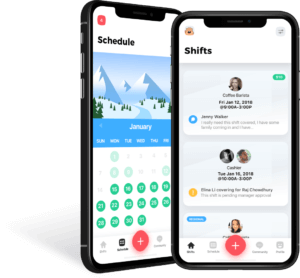Rescheduling shifts is not just a waste of time—it’s a waste of money too. That’s what Brett Patrontasch saw when he opened up a small house painting company, and it was a problem he wanted to solve. Coordinating schedules and shift swapping was taking up time, not to mention energy. The answer was simple: Employees needed an app. That’s how Shyft was born.
Shyft, a Seattle-based startup founded in 2015, seeks to solve this problem. It’s a mobile app where employees can shift-swap and coordinate schedules in a quick and transparent way. With 12,000 Starbucks employees using it and a partnership with Gap Inc., workers must be seeing its value. With $8.1M in funding, investors clearly see it too.
Origins
Before becoming the co-founder of Shyft, Brett Patrontasch founded a small house painting company called Scholars at Your Service, one that employed around 250 students at a time. He soon realized even trying to coordinate the shift schedule of a small company was a logistical nightmare –workers were using every method to communicate, from Facebook to texts. In all the confusion managers were wasting time, while employees were getting too many, or too few shifts.
If a small company was having this problem, Patrontasch figured, the challenges of global corporations must be worse. So he brought together a team of friends from the University of Toronto: CTO Daniel Chen, Lead Mobile Developer Kyle Liu, and Director of Growth Chris Pitchford.
The team had formerly worked on another workspace app called Coffee Mobile, but Patrontasch realized the app was too top-down, focusing on executive needs rather than those of employees. With Shyft, Patrontasch and his team sought to correct the issue, making an app that was useful to employees first, management second.
The problem
According to a census analysis, about two out of every five American workers are shift workers–about six million people. All of those individuals need to swap shifts, and all of them have no better means of doing so than a series of disparate messaging apps.
So why does shift-swapping lose company money? Shyft’s argument is this: For every call out looking for a shift swap a certain amount of time is lost while management and employees seek to reschedule shifts. Often enough, employees won’t be able to fill it, resulting in a no-show, which is a loss for employees and management alike. Shyft makes its argument using a calculator to tell you how much money you may be losing for this very issue.
How Shyft works

Photo credit: Shyft website
The app is free to download: You sign in as a ‘worker’ or ‘manager’ first. Once that’s done you’re asked to enter the region and the store you work at, and this adds you to a channel where you can communicate with all other employees at that store. In the case of managers you’re able to control the channel, approve or disapprove of shift swaps. But workers can also use the app to simply communicate amongst themselves.
According to Shyft 12,000 Starbucks workers, 7,500 McDonald’s workers, and 3,500 Old Navy users have signed up so far. Because these are all corporations employees are able to swap shifts across the whole country, not just their own store. The app includes a number of features: For instance, someone trying to unload an unpopular shift—say, during the holiday season—can offer a financial incentive. This helps users not only control their schedules but to pick up some extra cash.
How Shyft compares
Shyft helps users control schedules and pick up extra cash – for free.
This isn’t the only app created to solve shift management, but it certainly is the cheapest. Shyft’s competitive advantage is twofold: it’s not top-down, and it’s free. Other apps, such as Deputy and When I Work is manager focused, marketing itself towards managers looking to better manage their team. But Shyft can be downloaded by anyone–its power is contingent on how many others freely download it, even though it has features geared towards management. Most of these apps work from a monthly subscription (around $2), while Shift Worker costs around a dollar and can only be downloaded on Google Play. These are small prices (albeit they can balloon up annual budgets for companies with large workforces), but in the age of the internet, even a small paywall can be a real detriment towards an app’s initial success.
Who’s involved?
Shyft was picked up by Techstars, a Boulder-based accelerator with a market cap in the multi-billions.The Seed investment of $1.5M was sourced from such seasoned tech veterans as Heather Redman, venture capitalist group Madrona, as well as Russel Okung of the Seattle Seahawks and Edgar Martinez of the MBA. An impressive $6.5M was raised in its first funding round, led by Ignition Partners and Madrona, with managers from both groups joining Shyft’s board of directors. So far Shyft has partnered with Gap Inc., providing its services to workers from its many retail stores: Old Navy, Athleta and Banana Republic. The fact that Shyft is the 2018 Gold Prize Winner of the Seattle Business Magazine’s Tech Impact Award for Emerging Companies has also generated a significant amount of buzz.
With 4.7 rating in the app store it looks like Shyft is doing a great job helping workers swap shifts fast. With Starbucks spokesmen denying any knowledge of the app, it’ll be interesting to see whether or not this change is embraced by management. But with thousands of users already, it’s possible bosses won’t even need to know.
Subscribe to our newsletter



